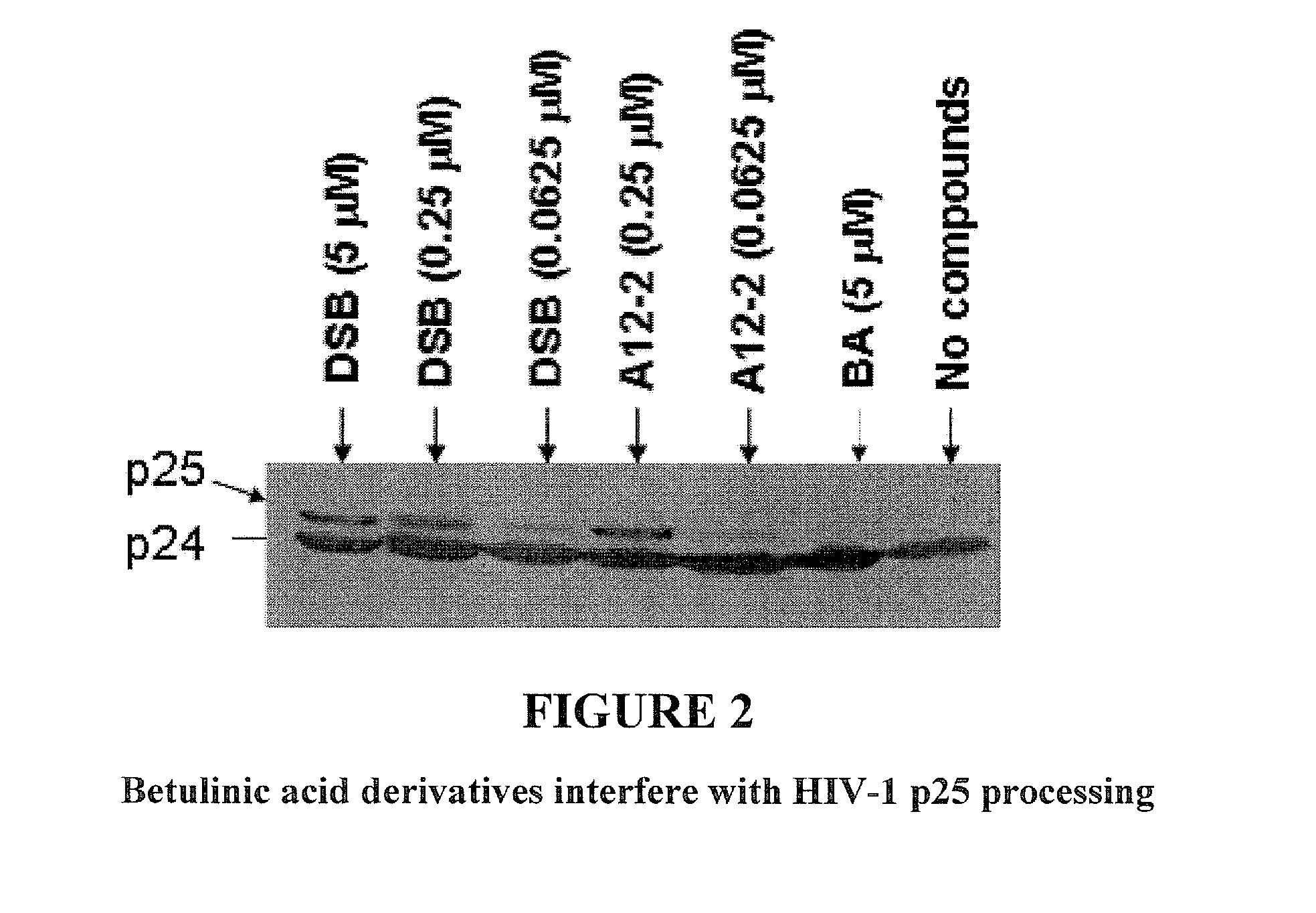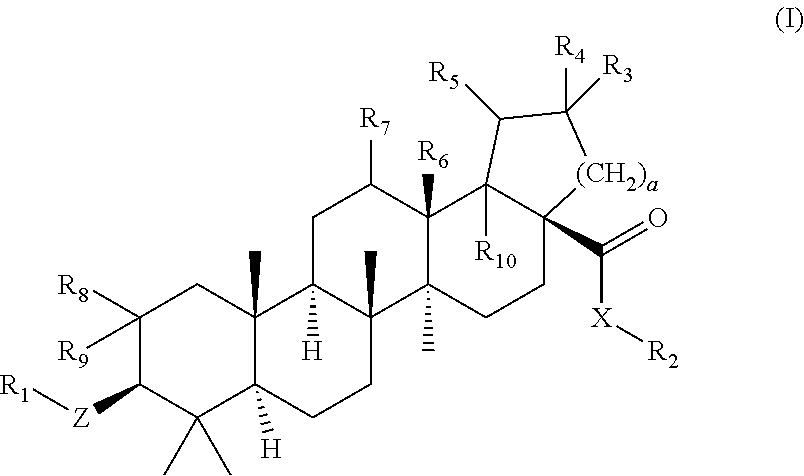Betulinic acid derivatives as Anti-hiv agents
a technology of betulinic acid and derivatives, applied in the field of betulinic acid derivatives as anti-hiv agents, can solve the problems of severe toxicities, side effects, and many species susceptible to retroviral infection
- Summary
- Abstract
- Description
- Claims
- Application Information
AI Technical Summary
Benefits of technology
Problems solved by technology
Method used
Image
Examples
example 1
[[N-[3β-O-(3′,3′-Dimethylsuccinyl)-lup-20(29)-en-28-oyl]-6-aminopenyl]-carbamoyl]methane (16)
[0132]
[0133]A reaction mixture of 3-O-acyl betulinic acid (300 mg, 0.6 mmol) and oxalyl chloride (6 mmol, 2 M in CH2Cl2) was stirred for 10 minutes, then the reaction mixture was dried under vacuum. The residue was dissolved in dichloromethane, and then the residue was slowly added to a solution of a 1,5-pentanediamine (400 mg, 2.5˜3.9 mmol) in dichloromethane (4 mL). After stirring overnight, the reaction mixture was concentrated, washed with water, then, dissolved in EtOH, and filtered to remove the insoluble solid. Then, the EtOH solution was concentrated under vacuum, and the residue was purified by silicon gel chromatography to yield the corresponding amine intermediates 16a.
[0134]After dissolving the amine intermediate 16a in anhydrous pyridine (4 mL), acetic anhydride (2 eq.) and DMAP (1 eq.) were added. After stirring overnight at room temperature, the reaction mixture was concentrat...
example 2
[[N-[3β-O-(3′,3′-Dimethylsuccinyl)-lup-20(29)-en-28-oyl]-6-aminohexyl]-carbamoyl]methane (17)
[0135]
[0136][[N-[3β-O-(3′,3′-Dimethylsuccinye-lup-20(29)-en-28-o yl]-6-aminohexyl]-carbamoyl]methane (17) were prepared by a similar manner as Example 1. Yield 17%. Mp 137° C. (dec). Positive FABMS m / z 725 (M+H)+; HR-FABMS calcd for C44H73N2O6 725.5474, found 725.5469. 1H NMR (300 MHz) δ 5.89 (1H, br s, NH), 5.70 (1H, t, J=6.0 Hz, NH), 4.70, 4.58 (each 1H, each s, ═CH2), 4.47 (1H, dd, J=6.5 Hz, J=10.5 Hz, H-3), 3.17-3.29 (4H, m, 2×CH, —NH), 3.10 (1H, dt, J=3.5 Hz, J=14.0 Hz, H-19), 2.56, 2.66 (each 1H, d, J=16.0 Hz, —CH2—COO—CH), 2.43 (1H, t, J=12.0 Hz, H-13), 1.99 (3H, s, COCH3), 1.67 (3H, s, CH3-30), 1.27, 1.29 (each 3H, s, —C(CH3)2—COOH), 0.79, 0.91, 0.94 (each 3H, s, 3×CH3) 0.81 (6H, s, 2×CH3).
example 3
[[N-[3β-O-(3′,3′-Dimethylsuccinyl)-lup-20(29)-en-28-oyl]-7-aminoheptyl]-carbamoyl]methane (18)
[0137]
[0138][[N-[3β-O-(3′,3′-Dimethylsuccinyl)-lup-20(29)-en-28-oyl]-7-aminoheptyl]-carbamoyl]methane (18) was prepared by a similar manner as Example 1. Yield 29%. Mp 117-120° C. Positive FABMS m / z 739 (M+H)+; HR-FABMS calcd for C45H75N2O6 739.5625, found 739.5615. 1H NMR (300 MHz) δ 5.62 (2H, t, J=5.0 Hz, 2×NH), 4.72, 4.59 (each 1H, each s, ═CH2), 4.49 (1H, dd, J=6.5 Hz, J=10.0 Hz, 1′-3), 3.09-3.30 (5H, m, 2×CH2—NH and H-19), 2.55, 2.67 (each 1H, d, J=16.0 Hz, —CH2—COO—CH), 2.46 (1H, t, J=11.0 Hz, H-13), 1.99 (3H, s, COCH3), 1.68 (3H, s, CH3-30), 1.29, 1.30 (each 3H, s, —C(CH3)2—COOH), 0.80, 0.93, 0.96 (each 3H, s, 3×CH3) 0.83 (6H, s, 2×CH3).
PUM
| Property | Measurement | Unit |
|---|---|---|
| pH | aaaaa | aaaaa |
| voltage | aaaaa | aaaaa |
| capacitance | aaaaa | aaaaa |
Abstract
Description
Claims
Application Information
 Login to View More
Login to View More - R&D
- Intellectual Property
- Life Sciences
- Materials
- Tech Scout
- Unparalleled Data Quality
- Higher Quality Content
- 60% Fewer Hallucinations
Browse by: Latest US Patents, China's latest patents, Technical Efficacy Thesaurus, Application Domain, Technology Topic, Popular Technical Reports.
© 2025 PatSnap. All rights reserved.Legal|Privacy policy|Modern Slavery Act Transparency Statement|Sitemap|About US| Contact US: help@patsnap.com



